Bergen op Zoom
Bergen op Zoom | |
|---|---|
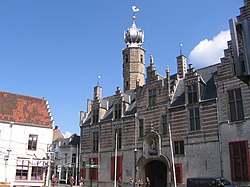 Markiezenhof in Bergen op Zoom | |
| Anthem:Merck toch hoe sterck | |
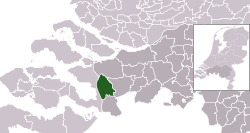 Location in North Brabant | |
| Coordinates:51°30′N4°18′E/ 51.500°N 4.300°E | |
| Country | Netherlands |
| Province | North Brabant |
| Government | |
| • Body | Municipal council |
| •Mayor | Frank Petter (CDA) |
| Area | |
| • Total | 93.13 km2(35.96 sq mi) |
| • Land | 79.96 km2(30.87 sq mi) |
| • Water | 13.17 km2(5.08 sq mi) |
| Elevation | 10 m (30 ft) |
| Population (January 2021)[4] | |
| • Total | 67,514 |
| • Density | 844/km2(2,190/sq mi) |
| Demonym | Bergenaar |
| Time zone | UTC+1(CET) |
| • Summer (DST) | UTC+2(CEST) |
| Postcode | 4600–4625, 4660–4664 |
| Area code | 0164 |
| Website | www |
Bergen op Zoom(Dutch pronunciation:[ˌbɛrɣə(n)ɔpˈsoːm];[a]calledBerrege[ˈbɛrəɣə]in thelocal dialect) is acityandmunicipalityin southwesternNetherlands.It is located in theprovinceofNorth Brabant,at the provincial border withZeeland.In January 2021, the municipality had a population of 67,514.
Etymology
[edit]The city was built on a site where two types of soil meet: sandy soil and marine clay. The sandy soil pushed against the marine clay, accumulating and forming hills over several centuries. People called those hills theBrabantse Wal,literally meaning "ramparts of Brabant".Zoomrefers to the border of these ramparts andbergenin Dutch means mountains or hills. The name has nothing to do with the little channel, the Zoom, which was later built through Bergen op Zoom.
History
[edit]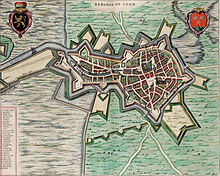

Bergen op Zoom was grantedcity statusprobably in 1212. In 1287 the city and its surroundings became alordshipas it was separated from the lordship ofBreda.The lordship was elevated to amargraviatein 1559. Several noble families, including theHouse of Glymes,ruled Bergen op Zoom in succession until 1795, although the title was only nominal since at least the seventeenth century.
During theearly modern period,Bergen op Zoom was a very strong fortress and one of the mainarmoriesandarsenalsof theUnited Provinces.It had a remarkable natural defensive site, surrounded as it was by marshes and easily floodedpolders.Furthermore, it could receive reinforcements and supplies by sea, if thebesiegingarmy did not have a fleet to blockade its port.
Due to these features, the city was one of the strategic points held by the Dutch during their revolt in theEighty Years War,beginning in the late sixteenth century. It was at that time besieged byAlessandro Farnesefirst in 1588,and byAmbrosio Spinolaa second time in 1622.Both sieges were unsuccessful, and Bergen op Zoom got the nicknameLa PucelleorThe Virginas it was never successfully taken in a siege.
In 1747, during theWar of the Austrian Succession,theFrench armylaid siegeto the city. Bergen op Zoom had been fortified by new works built at the beginning of the 17th century byMenno van Coehoorn,with three forts surrounding the city and a canalized diversion of theScheldtacting as a ditch around its walls. However, it had no second line of fortifications, nor anyfortress.After seventy days of siege, the city was taken and thoroughlysacked;the garrison was slaughtered.
During theWar of the Sixth Coalition,the town wasagain besiegedby the British in March 1814 in a failed attempt to dislodge the French garrison.
Trading town
[edit]During the reign of Jan II van Glymes (1417–1494), nicknamed "Jan metten Lippen" (meaning "Jan with the big lips", probably caused by an infection), a surge in economic growth occurred in the city. Large fairs were held twice a year, in spring and fall, that were known both nationally and internationally. Merchants from all over Europe came to Bergen op Zoom to sell their goods.
Because of this major economic growth, the Sint-Gertrudischurch was enlarged. The enlargement was called theNieuw Werckbut was never finished, because of the economic recession of the mid-16th century. It fell into ruin. The economic recession was largely caused by the poor accessibility of the port, due to a number of floods in Zeeland and West-Brabant. Because of the great reliance on the port, the economic growth received a major blow. In addition, the modernization of trade techniques, such as establishing of a permanent stock exchange instead of the fairs, which took place twice a year, also damaged the local economy.
The fairs continued until 1910. Despite the end of the two big fairs, Bergen op Zoom still hosts all kinds of smaller fairs and events.
Religion
[edit]During theEighty Years' War,Bergen op Zoom chose the side of the Dutch Republic, and, simultaneously, Protestantism. The Catholics of the city either adapted or moved to the surrounding countryside, which remained largely Catholic. The inhabitants who chose to stay Catholic went to church in secret barns and houses, since the local Sint-Getrudischurch was assigned to the Protestant community.
Slowly, most of the city council members of Bergen op Zoom became Protestant. Protestants dominated the council until the 18th century. After that, the number of Catholics in Bergen op Zoom increased and, during the second part of the 18th century, a majority of Bergen op Zoom's population was Catholic again. Although the Catholics enjoyed religious freedom during the French period in 1795–1814, their emancipation did not take place until later.
In 1832, a Catholic parish, the ‘Heilige Maagd ten Ophemeling’, was allowed to have its own church. In the same period, the Jewish community built a synagogue for their use.
In 1972, the Protestant community, after the loss of many members, gave the Sint-Getrudischurch to the Catholic parish. Since the return of the Church, Catholic services have been held here again.
As a result ofTurkishandMoroccanimmigration to the Netherlands, the city has a significant Muslim minority.[5]
Population centres
[edit]- Bergen op Zoom(population: 65,691, July 2006)
- Heimolen
- Halsteren(11,410)
- Lepelstraat(2,070)
- Kladde
City of Bergen op Zoom
[edit]-
Gevangenpoort, the oldest monument in Bergen op Zoom
-
Grote Markt
-
Bergen op Zoom, fountain and bridge in park
-
The Marketplace at Bergen op Zoom.Attributed to Abel Grimmer, 1590s. National Gallery of Art, Washington.[6]
The Markiezenhof Palace, built in the fifteenth and sixteenth centuries, houses acultural centreand a museum with a picturesque courtyard, paintings, period rooms, and temporary exhibitions. SABICInnovative Plastics operates a major manufacturing facility in Bergen op Zoom.[7]Philip Morriswas another major employer until it closed its plant in 2014.[8]
Transport
[edit]Notable people
[edit]
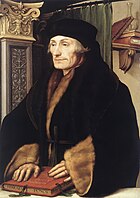

The arts
[edit]- Jacob Obrecht(1457–1505) composer, mainly of sacred music
- Desiderius Erasmus(1466–1536) humanist, philosopher, author[9]
- Abel Grimmer(1570–1619) a Flemish late Renaissance painter, mainly of landscapes
- Gerrit Houckgeest(1600–1661) aDutch Golden Agepainter of architectural scenes and church interiors
- Bartram de Fouchier(1609–1673) aDutch Golden Agepainter
- Marcus Zuerius van Boxhorn(1612–1653) historian, author and scholar
- Thomas Willeboirts Bosschaert(1613–1654) aFlemish Baroque painter
- Pieter van der Willigen(1634–1694) aFlemish Baroque painter
- Govert-Marinus Augustijn(1871–1963) a DutchArt Nouveaupotter
- Kees Smout(1876–1961) a Dutch sculptor
- Anton van Duinkerken(1903–1968) a Dutch poet, essayist and academic
- Louis Boekhout(1919–2012) a Dutch painter who emigrated to Québec, Canada
- Pleuni Touw(born 1938) a Dutch film, television and theatre actress[10]
- Adriaan Ditvoorst(1940–1987) a Dutch film director, screenwriter[11]
- Cornald Maas(born 1967) a Dutch television presenter
- Martin Fondse(born 1967) a Dutch pianist and composer who plays the vibrandoneon
- Bob van Luijt(born 1985) a Dutch technology entrepreneur, technologist and new media artist
- Julia Boschman(born 2002) a Dutch singer in famous girl group K3
Public thinking and public service
[edit]- Pieter Gerardus van Overstraten(1755–1801) lastGovernor-General of the Dutch East Indies
- Gerrit Verdooren van Asperen(1757–1824) vice-admiral of theRoyal Netherlands Navy
- Jacob Van Braam(1729–1792) a soldier of fortune, swordmaster and mercenary.[12]
- Gillis Pieter de Neve(1823–1883) commander of theRoyal Netherlands East Indies Army
- Albert Vogel(1874–1933) a Dutch Army officer and teacher
- Peter Sitsen(1885–1945) a military officer, building contractor and public servant in colonial Indonesia
- Ed Nijpels(born 1950) a retired Dutch politician
- Virginie Korte-van Hemel(1929–2014) a Dutch politician
- Bernard de Wit(born 1945) a Dutch theoretical physicist and academic
- Paul Schnabel(born 1948) a Dutch sociologist, academic and politician
- Wim Crusio(born 1954) a Dutch behavioralneurogeneticistand academic
- Fatma Koşer Kaya(born 1968) a Dutch lawyer and politician of Turkish origin
Sports
[edit]
- Reindert de Favauge(1872–1949) a sport shooter, competed at the1908and1920 Summer Olympics
- Henk Kersken(1880–1967) a sailor who competed at the1928 Summer Olympics
- Barent Momma(1897–1936) a modern pentathlete, competed at the1924 Summer Olympics
- Willem van Rhijn(1903–1979) a modern pentathlete, competed at the1928and1932 Summer Olympics
- Janus van der Zande(1924–2016) a marathon runner, competed in the1952 Summer Olympics
- Maarten Sikking(1948–2009) a field hockey goalkeeper, competed at the1972and1976 Summer Olympics
- Rico Verhoeven(born 1989) a kickboxer
- Oussama Idrissi(born 1996) a footballer
Twin towns — sister cities
[edit]Bergen op Zoom istwinnedwith:[13]
 Oudenaarde,Belgium
Oudenaarde,Belgium Szczecinek,Poland
Szczecinek,Poland
See also
[edit]Notes
[edit]References
[edit]- ^"Burgemeester"[Mayor] (in Dutch). Gemeente Bergen op Zoom. Archived fromthe originalon 22 April 2014.Retrieved21 April2014.
- ^"Kerncijfers wijken en buurten 2020"[Key figures for neighbourhoods 2020].StatLine(in Dutch).CBS.24 July 2020.Retrieved19 September2020.
- ^"Postcodetool for 4611AR".Actueel Hoogtebestand Nederland(in Dutch). Het Waterschapshuis.Retrieved21 April2014.
- ^"Bevolkingsontwikkeling; regio per maand"[Population growth; regions per month].CBS Statline(in Dutch).CBS.1 January 2021.Retrieved2 January2022.
- ^Statistiek, Centraal Bureau voor de (2016-12-22)."Helft Nederlanders is kerkelijk of religieus".Centraal Bureau voor de Statistiek(in Dutch).Retrieved2023-11-19.
- ^"Collection: The Marketplace in Bergen op Zoom".National Gallery of Art.Archivedfrom the original on 2020-08-03.Retrieved24 July2021.
- ^"SAIC Innovative Plastics B.V".Bloomberg.Retrieved2015-03-10.
- ^"Tobacco Firm Philip Morris to End Production in Netherlands".The Wall Street Journal.2014-04-04.Retrieved2015-03-10.
- ^.Encyclopædia Britannica.Vol. 9 (11th ed.). 1911.
- ^IMDb Databaseretrieved 07 October 2019
- ^IMDb Databaseretrieved 06 October 2019
- ^.Encyclopedia Americana.Vol. XXVII. 1920.
- ^"Stichting Jumelage Bergen op Zoom"(in Dutch). Stichting Jumelage Bergen op Zoom.Retrieved2024-06-15.
Further reading
[edit]- A Ballad on the Taking of Bergen-Op Zoom.London: M. Cooper, 1747.
- Merck toch hoe sterck.The anthem of the city: A. Valerius, 1626.
- Bot, Marie-Louise, and Gouke J. Bonsel.The Bergen Op Zoom-Quality of Life Survey: A Dutch Contribution to the Collaborative Study of the European Common Core Group.Rotterdam: Dept. of Public Health and Social Medicine/Institute for Medical Technology Assessment, Erasmus University Rotterdam, 1989.ISBN90-72245-45-8
- Edler, Florence.Attendance at the Fairs of Bergen-Op-Zoom 1538–1544.Bergen op Zoom: [s.n.], 1936.
- Smyth, James Carmichael.Plans of the Attacks Upon Antwerp, Bergen-Op-Zoom, Cambray, Peronne, Maubeuge, Landrecy, Marienbourg, Philippeville and Rocroy, By the British and Prussian Armies in the Campaigns of 1814 and of 1815.1817.
- 1939–1945 The War Dead of the Commonwealth: The Register of the Names of Those Who Fell and Are Buried in Cemeteries in the Netherlands: Bergen Op Zoom Canadian War Cemetery.Maidenhead: Commonwealth War Graves Commission, 1994.
External links
[edit] Media related toBergen op Zoomat Wikimedia Commons
Media related toBergen op Zoomat Wikimedia Commons- Official website







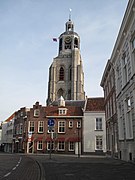

![The Marketplace at Bergen op Zoom. Attributed to Abel Grimmer, 1590s. National Gallery of Art, Washington.[6]](https://upload.wikimedia.org/wikipedia/commons/thumb/d/dc/The_Marketplace_in_Bergen_op_Zoom_E11381.jpg/234px-The_Marketplace_in_Bergen_op_Zoom_E11381.jpg)
